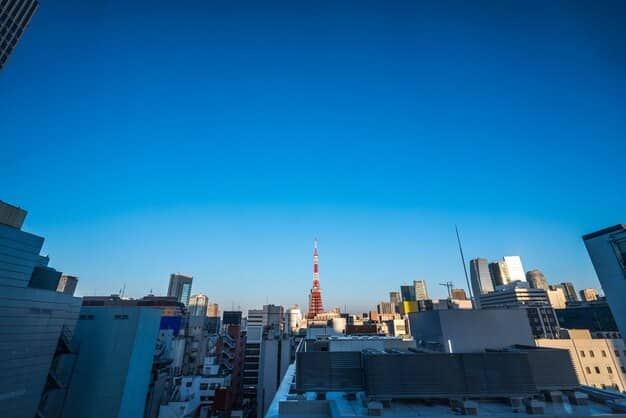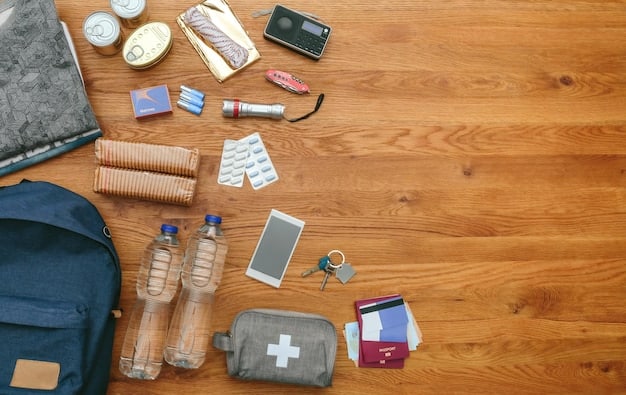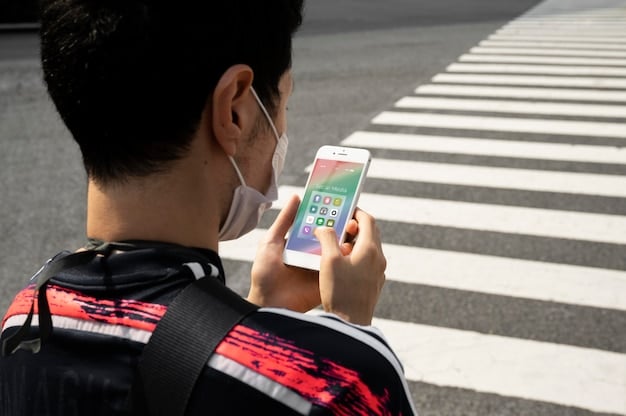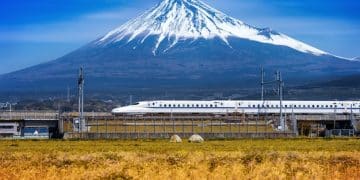Japan’s Emergency Preparedness Guide: US Tourist Safety

Japan’s Emergency Preparedness Guide provides essential information for US tourists on how to stay safe during earthquakes, typhoons, and other potential disasters, ensuring a secure and informed travel experience.
Planning a trip to Japan? While its cultural beauty and technological advancements might be your focus, understanding Japan’s Emergency Preparedness Guide: Staying Safe as a US Tourist is crucial for a secure and enjoyable experience.
Japan’s unique emergency landscape
Japan is renowned for its stunning landscapes and vibrant cities. However, its location also makes it prone to natural disasters. Understanding these risks is the first step in ensuring a safe trip.
From earthquakes to typhoons, Japan faces a range of natural hazards. This section will provide an overview, helping you to be aware and prepared for potential emergencies during your visit.
Seismic activity and earthquakes
Japan is located in one of the world’s most seismically active areas. Earthquakes are a common occurrence, and it’s important to understand how to respond during one.
Typhoons and seasonal storms
Typhoons, similar to hurricanes, can bring heavy rainfall and strong winds. Knowing when typhoon season is and how to stay safe is essential.
- Check weather updates regularly.
- Know evacuation routes from your accommodation.
- Secure loose objects outside your lodging to prevent them from becoming projectiles.
Being informed about Japan’s emergency landscape can significantly enhance your safety as a US tourist. Awareness and preparation are key.

Essential emergency kit for travelers
Packing an emergency kit ensures you have the necessary supplies readily available in case of a disaster. A comprehensive kit can provide comfort and safety during unexpected events.
This section outlines what to include in your emergency kit, focusing on items that are most useful for tourists. It covers communication, sustenance, and basic medical needs.
Critical items to include
A comprehensive emergency kit should include items that address basic needs like water, food, and first aid. These items can make a significant difference in your comfort and safety.
Staying connected: power banks and communication tools
Communication is vital during emergencies. Ensure you have the means to stay connected and informed.
- Portable power bank for charging devices.
- A whistle to signal for help.
- Copies of important documents in a waterproof bag.
Having an emergency kit packed with the right items ensures you’re prepared for any unexpected situation during your trip. Preparing in advance can provide peace of mind.
Navigating Japan’s emergency alert system
Japan has a sophisticated emergency alert system designed to keep residents and visitors informed. Understanding how the system works is essential for your safety.
This section delves into the various methods Japan uses to disseminate emergency information. It explains how to interpret alerts so you can take appropriate actions quickly.
Understanding Japan’s J-Alert system
The J-Alert system is a nationwide warning system that broadcasts alerts through various channels. Knowing what the alerts mean can help you respond effectively.
Smartphone apps for emergency alerts
Several smartphone apps provide real-time emergency alerts in English. These apps can be invaluable for tourists.
- Japan Official Travel App: Provides vital travel information, including disaster alerts.
- Safety Tips: Offered by the Japan National Tourism Organization, providing alerts and safety tips.
- NHK World-Japan: Offers news and emergency updates in multiple languages.
Knowing how to navigate Japan’s emergency alert system ensures you’re always informed and can take necessary precautions. Staying updated can significantly impact your safety.

Evacuation procedures and safety protocols
Knowing evacuation procedures and safety protocols is essential for staying safe during an emergency. Understanding what to do and where to go can save lives.
This section covers the key steps to take during different types of emergencies. It includes guidance on evacuation routes, meeting points, and how to follow local instructions.
Earthquake safety: Drop, cover, and hold on
During an earthquake, the “Drop, Cover, and Hold On” method is the most effective way to protect yourself.
Typhoon preparedness: Staying indoors and avoiding risks
When a typhoon hits, staying indoors and avoiding unnecessary risks is crucial. This section provides guidance on typhoon preparedness.
- Stay inside a sturdy building, away from windows.
- Avoid going outside unless it’s absolutely necessary.
- Monitor weather updates and follow official instructions.
Understanding evacuation procedures and safety protocols is key to navigating emergencies effectively. Knowing what to do in different situations can increase your safety.
Communicating during an emergency: language barriers and resources
Communication can be challenging during an emergency, especially if you don’t speak Japanese. Knowing how to overcome language barriers is vital.
This section provides tips on using translation apps, learning key phrases, and leveraging resources available in English. It focuses on ensuring you can understand instructions and seek help effectively.
Translation apps and helpful phrases
Translation apps can be invaluable tools for understanding instructions and communicating needs.
Emergency contact information and English-speaking support
Having access to emergency contact information and English-speaking support can be crucial. This section includes relevant contacts and resources.
- Japan Helpline: Provides 24/7 assistance in English.
- Your embassy or consulate: Offers support and guidance for US citizens.
- Local police and fire departments: Accessible by dialing 110 and 119, respectively.
Effectively communicating during an emergency is crucial for your safety and well-being. Overcoming language barriers ensures you can access the help and information you need.
Post-disaster support and recovery for tourists
Knowing what support and recovery resources are available after a disaster can help you navigate the aftermath and continue your journey safely. Understanding your options is essential.
This section outlines the types of support available, including temporary accommodation, financial assistance, and travel assistance. It provides guidance on accessing these resources and re-planning your trip.
Finding temporary accommodation and assistance
After a disaster, finding temporary accommodation and assistance is often a priority. Resources are available to help you locate safe places to stay.
Repatriation options with the US Embassy
In severe cases, repatriation may be necessary. The US Embassy can provide guidance on repatriation options.
Understanding post-disaster support and recovery options ensures you can navigate the aftermath of an emergency effectively. Having access to support can help you resume your travels.
| Key Point | Brief Description |
|---|---|
| 🚨 Emergency Kit | Pack essential items like water, food, first aid, and a power bank. |
| 📱 Alert Apps | Download apps like Japan Official Travel App for real-time alerts. |
| ⚠️ Evacuation | Know the evacuation routes and follow local instructions. |
| 🗣️ Communication | Use translation apps and learn key phrases for emergencies. |
FAQ
▼
Your emergency kit should include water, non-perishable food, a first aid kit, a flashlight, a portable charger, copies of important documents, and a whistle. These items ensure basic needs are covered.
▼
Download the Japan Official Travel App or Safety Tips app to receive real-time emergency alerts in English. These apps provide updates on earthquakes, typhoons, and other disasters.
▼
During an earthquake, follow the “Drop, Cover, and Hold On” method. Drop to the ground, cover your head and neck, and hold onto something sturdy until the shaking stops.
▼
Contact the Japan Helpline for 24/7 assistance in English. You can also reach out to your embassy or consulate for support and guidance during emergencies.
▼
After a disaster, seek temporary accommodation through local authorities or support organizations. Financial assistance and travel assistance may also be available to help you resume your travels.
Conclusion
Being prepared for emergencies is an essential aspect of traveling in Japan. By understanding the risks, packing an emergency kit, knowing evacuation procedures, and accessing the right resources, US tourists can ensure a safer and more secure travel experience. Stay informed, stay safe, and enjoy your trip to Japan confidently.





